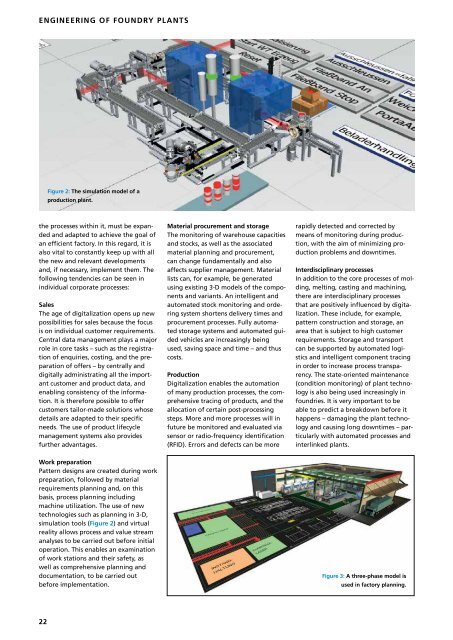CPT International 02/2019
- No tags were found...
Create successful ePaper yourself
Turn your PDF publications into a flip-book with our unique Google optimized e-Paper software.
ENGINEERING OF FOUNDRY PLANTS<br />
Figure 2: The simulation model of a<br />
production plant.<br />
the processes within it, must be expanded<br />
and adapted to achieve the goal of<br />
an efficient factory. In this regard, it is<br />
also vital to constantly keep up with all<br />
the new and relevant developments<br />
and, if necessary, implement them. The<br />
following tendencies can be seen in<br />
individual corporate processes:<br />
Sales<br />
The age of digitalization opens up new<br />
possibilities for sales because the focus<br />
is on individual customer requirements.<br />
Central data management plays a major<br />
role in core tasks – such as the registration<br />
of enquiries, costing, and the preparation<br />
of offers – by centrally and<br />
digitally administrating all the important<br />
customer and product data, and<br />
enabling consistency of the information.<br />
It is therefore possible to offer<br />
customers tailor-made solutions whose<br />
details are adapted to their specific<br />
needs. The use of product lifecycle<br />
management systems also provides<br />
further advantages.<br />
Material procurement and storage<br />
The monitoring of warehouse capacities<br />
and stocks, as well as the associated<br />
material planning and procurement,<br />
can change fundamentally and also<br />
affects supplier management. Material<br />
lists can, for example, be generated<br />
using existing 3-D models of the components<br />
and variants. An intelligent and<br />
automated stock monitoring and ordering<br />
system shortens delivery times and<br />
procurement processes. Fully automated<br />
storage systems and automated guided<br />
vehicles are increasingly being<br />
used, saving space and time – and thus<br />
costs.<br />
Production<br />
Digitalization enables the automation<br />
of many production processes, the comprehensive<br />
tracing of products, and the<br />
allocation of certain post-processing<br />
steps. More and more processes will in<br />
future be monitored and evaluated via<br />
sensor or radio-frequency identification<br />
(RFID). Errors and defects can be more<br />
rapidly detected and corrected by<br />
means of monitoring during production,<br />
with the aim of minimizing production<br />
problems and downtimes.<br />
Interdisciplinary processes<br />
In addition to the core processes of molding,<br />
melting, casting and machining,<br />
there are interdisciplinary processes<br />
that are positively influenced by digitalization.<br />
These include, for example,<br />
pattern construction and storage, an<br />
area that is subject to high customer<br />
requirements. Storage and transport<br />
can be supported by automated logistics<br />
and intelligent component tracing<br />
in order to increase process transparency.<br />
The state-oriented maintenance<br />
(condition monitoring) of plant technology<br />
is also being used increasingly in<br />
foundries. It is very important to be<br />
able to predict a breakdown before it<br />
happens – damaging the plant technology<br />
and causing long downtimes – particularly<br />
with automated processes and<br />
interlinked plants.<br />
Work preparation<br />
Pattern designs are created during work<br />
preparation, followed by material<br />
requirements planning and, on this<br />
basis, process planning including<br />
machine utilization. The use of new<br />
technologies such as planning in 3-D,<br />
simulation tools (Figure 2) and virtual<br />
reality allows process and value stream<br />
analyses to be carried out before initial<br />
operation. This enables an examination<br />
of work stations and their safety, as<br />
well as comprehensive planning and<br />
documentation, to be carried out<br />
before implementation.<br />
Figure 3: A three-phase model is<br />
used in factory planning.<br />
22

















